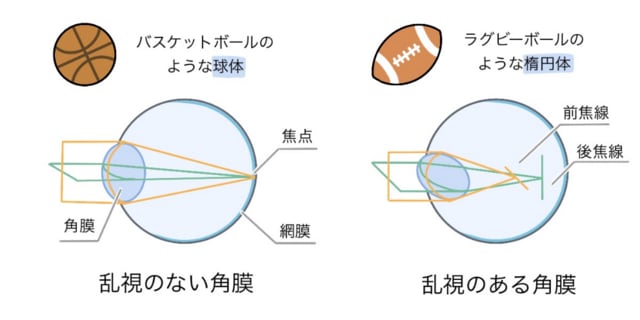7月14~15日に東京で開催された第66回日本コンタクトレンズ学会の報告の続きです。
今回は、前回お伝えした
① 乱視の矯正
について解説させていただきます。
① 乱視の矯正(乱視用ソフトコンタクト)
海外ではソフトコンタクトでも乱視矯正を入れる場合が多いと前回お伝えしました。
乱視とはどのような状態でしょうか?
メガネやコンタクトレンズで乱視を矯正している方でも、乱視を理解されている方は意外と少ないです。
一言でいうと「角膜(黒目)のゆがみ具合」が乱視の強弱となります。
以下、参天製薬のホームページから転載します。
・・・・・・・・・・・・・・・・・・・・・・・・・・・・・・・・・・
乱視とは、屈折力が屈折点により異なるために、焦点を結ばない状態のことを言い、正乱視と不正乱視とに分けられます(図 17)。
正乱視は角膜や水晶体のカーブが方向によって違うため(例:ラグビーボール)、屈折力が縦と横、あるいは斜めで異なり、焦点を一点に合わせることができません。
主に角膜のひずみが原因ですが、近視や遠視と組み合わさって起こる場合がほとんどです。正乱視があると一方向の線のみが明確に見えますが、他の方向はぼやけて見えます(図 18)。
不正乱視は炎症やケガなどによって角膜表面に凹凸が生じたために正常に像が結ばれない状態を言います。


(上図: HOYA ホームページより転載)
乱視の治療
正乱視は円柱レンズの眼鏡やコンタクトレンズ(コンタクト)で矯正できます。眼のひずみと逆方向にひずませる円柱レンズにより焦点を合わせます(図 21)。
不正乱視は角膜の表面に凹凸があるため眼鏡では矯正が不可能です。コンタクトで矯正されますが、矯正にはハードコンタクト(ハード)の方が適しています(図 22)。
コンタクトで矯正できない場合は屈折矯正手術または角膜移植を行います。

・・・・・・・・・・・・・・・・・・・・・・・・・・・・・・・・・・
ラグビーボールのような形状をした角膜が「乱視」です。
ハードコンタクトではレンズ自体が形の安定した「球体」ですので乱視の矯正に適します。
ハードコンタクトは涙の海(涙液層)のうえに浮かぶ船のように角膜に「乗り」ます。
そのためレンズと涙液層で角膜の形がハードコンタクトレンズの「球体」形に合うことで乱視が理論上無くなるからです。
ソフトとハードを使い比べると分かりますが、殆どの方でハードの方が良い視力が得られます。
しかし、現在では使い捨てソフトコンタクトレンズが主流となっています。
インターネット通販など、日本では簡単にレンズ購入が事実上可能となっています。
眼科への受診をしない場合は乱視を考慮しないレンズを購入されている可能性が高そうです。
ソフトは素材が柔らかく角膜の「楕円体」にレンズが形を合せてしまいます。
そのままでは乱視の矯正が出来ません。
そのためソフトでは適切な乱視矯正の入ったものを使用しないと、良い見え方にならないのです。
乱視矯正ソフトは価格が高くなることもあり、多少の乱視では敢えて乱視を無視して通常のソフトを選択することが日本では多いようです。
欧米では乱視の強さに関係なく、「乱視矯正ソフト」を勧めることが多いようです。
患者さんの満足度が良ければ、無理に乱視矯正をする必要は無いと思いますが、
そのための適切な判断のためには眼科での処方、検診をお勧めします。
-----------------------------------------------------------------------
おぐりクリニック https://oguriganka.or.jp/
〒526-0847
滋賀県長浜市山階町451
ネットショップ オピュール https://www.rakuten.co.jp/oland/
メールマガジンの登録はこちら
https://oguriganka.jp/p/r/1ug9kI8X
This is a continuation of the report from the 66th Japan Contact Lens Society held in Tokyo on July 14-15.
This time, I will explain about
① Correction of Astigmatism
, which I mentioned last time.
① Correction of Astigmatism (Soft Contact Lenses for Astigmatism)
In the last article, I mentioned that in foreign countries, astigmatism correction is often included even with soft contact lenses.
What is astigmatism?
Even among people who have astigmatism corrected with glasses or contact lenses, surprisingly few people understand astigmatism.
In a word, the degree of distortion of the cornea (iris) determines the strength of astigmatism.
The following is reproduced from the Santen Pharmaceutical website.
・・・・・・・・・・・・・・・・・・・・・・・・・・・・・・・
Astigmatism is a condition in which the refractive power differs depending on the point of refraction, resulting in a lack of focus. It is divided into regular astigmatism and irregular astigmatism (Figure 17).
Regular astigmatism is caused by the fact that the curve of the cornea or lens differs depending on the direction (e.g., a rugby ball), and the refractive power differs vertically, horizontally, or diagonally, making it impossible to focus on a single point.
It is mainly caused by corneal distortion, but it often occurs in combination with myopia or hyperopia. With regular astigmatism, only lines in one direction are clearly visible, while lines in other directions are blurred (Figure 18).
Irregular astigmatism is a condition in which an image cannot be formed properly due to unevenness on the corneal surface caused by inflammation or injury.
(Above figure: Reprinted from the HOYA website)
Treatment for astigmatism
Regular astigmatism can be corrected with glasses or contact lenses with cylindrical lenses. The focus is adjusted by using cylindrical lenses that distort in the opposite direction to the distortion of the eye (Figure 21).
Irregular astigmatism cannot be corrected with glasses because the surface of the cornea is uneven. It can be corrected with contact lenses, but hard contact lenses are more suitable for correction (Figure 22).
If contact lenses are not able to correct the condition, refractive surgery or a corneal transplant will be performed.
・・・・・・・・・・・・・・・・・・・・・・・・・・・・・・・・・・
A cornea shaped like a rugby ball is "astigmatism."
Hard contact lenses are suitable for correcting astigmatism because the lens itself is a stable "sphere."
Hard contact lenses "ride" on the cornea like a boat floating on an ocean of tears (tear film).
Theoretically, astigmatism will be eliminated if the lens and tear film match the shape of the cornea to the "sphere" of the hard contact lens.
If you compare soft and hard contact lenses, you will see that most people will achieve better vision with hard contact lenses.
However, disposable soft contact lenses are now mainstream.
In Japan, it is virtually easy to purchase lenses, such as through online shopping.
If you do not visit an ophthalmologist, it is likely that you have purchased lenses that do not take astigmatism into consideration.
Soft contact lenses are made of a soft material and the lens fits the shape of the cornea's "ellipsoid."
Astigmatism cannot be corrected as is.
Therefore, unless you use software that contains the appropriate astigmatism correction, you will not see well.
Astigmatism correction software can be expensive, in Japan it seems that people with slight astigmatism often choose regular software and ignore the astigmatism.
In Europe and the United States, it seems that "astigmatism correction software" is often recommended regardless of the strength of the astigmatism.
If the patient is satisfied, there is no need to force astigmatism correction,
but we recommend a prescription and examination by an ophthalmologist to make an appropriate decision.
这是7月14日至15日在东京举行的第66届日本隐形眼镜协会报告的延续。
这次,我上次已经告诉过你了。
① 矫正散光
我会解释一下。
① 散光矫正(散光软隐形眼镜)
上次我提到散光矫正在国外经常应用于软隐形眼镜。
散光是一种什么样的情况?
令人惊讶的是,很少有人了解散光,即使他们用眼镜或隐形眼镜矫正散光。
简而言之,角膜(黑眼球)的扭曲程度决定了散光的强度。
以下转载自参天制药主页。
・・・・・・・・・・・・・・・・・・・・・・・・・・・・・・・・
散光是指因屈光点不同而屈光力不同而导致眼睛无法聚焦的情况,分为规则散光和不规则散光(图17)。
对于规则散光,角膜和晶状体的曲线根据方向(例如橄榄球)的不同而不同,因此屈光力在垂直、水平或对角线方向上不同,从而无法聚焦在单个点上。
它主要是由角膜变形引起的,但常与近视或远视同时发生。对于规则散光,一个方向的线条清晰可见,而其他方向的线条则显得模糊(图 18)。
不规则散光是一种由于炎症或损伤而导致角膜表面不均匀,导致图像无法正确聚焦的情况。
(上图:转载自HOYA主页)
散光治疗
常规散光可以通过柱面眼镜或隐形眼镜矫正。聚焦是通过柱面透镜实现的,柱面透镜使眼睛向相反方向扭曲(图 21)。
不规则散光无法通过眼镜矫正,因为角膜表面不平坦。可以用接触来校正,但硬接触更适合校正(图22)。
如果无法通过隐形眼镜矫正病情,可以进行屈光手术或角膜移植。
・・・・・・・・・・・・・・・・・・・・・・・・・・・・・・・・
形状像橄榄球的角膜称为散光。
采用硬接触镜片,镜片本身具有稳定的球面形状,适合矫正散光。
硬性隐形眼镜在角膜上“行驶”,就像一艘漂浮在泪海(泪膜)上的船。
因此,理论上可以通过使角膜形状与硬性隐形眼镜的“球形”形状相匹配的镜片和泪膜来消除散光。
如果您比较软件和硬件,您会发现大多数人通过硬件获得了更好的视力。
然而,一次性软隐形眼镜现在已成为主流。
在日本,几乎可以通过网上购物轻松购买镜片。
如果您没有去看眼科医生,您购买的镜片很可能没有考虑散光的情况。
软镜片由柔软的材料制成,镜片符合角膜的椭球面。
散光不能按原样矫正。
因此,除非您使用具有适当散光矫正功能的软件,否则您将无法看得清楚。
散光矫正软件可能很昂贵,在日本,如果有一定的散光,很多人会选择忽略散光并选择常规软件。
在欧美,无论散光的强度如何,往往都会推荐“散光矫正软件”。
如果患者满意,则无需强行矫正散光。
为此,我们建议您向眼科医生开处方并进行检查,以便做出正确的判断。
















